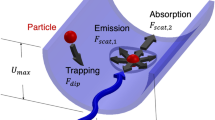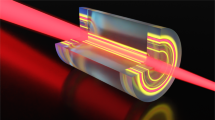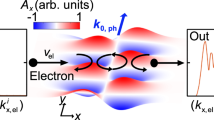Abstract
The refraction of light at an interface is familiar as a rainbow or the 'bending' of a pencil in a glass of water. Here we show that particles can also be refracted and even totally internally reflected, as evidenced by an electron beam of 28.5 × 109 electron volts being deflected by more than a milli-radian upon exiting a passive boundary between a plasma and a gas — the electron beam is bent away from the normal to the interface, just like light leaving a medium of higher refractive index. This phenomenon could lead to the replacement of magnetic kickers by fast optical kickers in particle accelerators, for example, or to compact magnet-less storage rings in which beams are guided by plasma fibre optics.
Similar content being viewed by others
Main
Refraction is caused by electrostatic plasma fields set up when plasma electrons are expelled by the collective space charge force of the head of the beam. The plasma ions in the beam path are more massive and remain, constituting a positively charged channel through which the latter part of the beam travels. The ions provide a net force that focuses the beam1,2. When the beam comes close to the plasma boundary, the ion channel becomes asymmetric, producing a deflecting force in addition to the focusing force. This formation of an asymmetric plasma lens3 gives rise to the bending of the beam path at the interface.
The order of magnitude of this deflection can be estimated, yielding an expression for the deflection angle, θ, as a function of the incident angle, φ. This is the effective non-linear Snell's law for the electron beam refraction, valid for φ greater than θ:

where N/√(√(2π))σz is the charge per unit length of the beam, re is the classical electron radius, γ is the beam's energy in units of mc2 and α is a factor of order one that is a weak function of plasma density and bunch length. When φ is less than θ, this equation breaks down and the beam is internally reflected. Simulations4 show that θ ≈ φ (critical reflection) for small values of φ.
We tested this analytical model by using the electron beam at the Stanford Linear Accelerator Center (Final Focus test facility), as described5,6. Sample results are shown in Fig. 1 and compared with a full three-dimensional electromagnetic particle-in-cell computer simulation7. In Fig. 1a, the solid curve represents the prediction from the model (with α = 0.2): for incident angles smaller than 1.3 mrad, the beam appears to be internally reflected, in agreement with the model.
a, Actual electron-beam deflection (circles), measured using a beam-position monitor, and the theoretical deflection (blue line) as a function of the incident angle. b, Simulation: perspective image of a beam emerging from plasma (turquoise); the inward motion of the plasma electrons is visible as a depression in the plasma surface behind the beam. c, Experiment: image of the beam downstream of the plasma, showing the deflected beam and the undeflected transient (at the crosshairs); d, head-on view of image in b. The beam consisted of 1.9 × 1010 electrons at 28.5 GeV in a gaussian bunch of length σz = 0.7 mm and spot size σx ≈ σy ≈ 40 μm. The plasma, with radius 2.3 mm, length 1.4 m and density 1 × 1014 cm −3, was created by photoionization of lithium vapour by an ArF laser. The angle, φ, between the electrons' initial trajectory and the plasma boundary was controlled by adjusting the tilt angle of the final laser-beam mirror.
Figure 1b shows a snapshot of the real space of the beam and plasma electron density (turquoise) from a simulation. A transient at the head of the beam is apparent because of the finite time that it takes the plasma to respond to the beam. The tail portion is deflected towards the plasma and is near the plasma boundary. The transient results in the characteristic splitting of the beam images downstream, as shown in Fig. 1c, d.
The simulations and experimental results presented here show that it is possible to refract and even reflect a particle beam from a dilute plasma gas. Remarkably, for a 28.5-GeV beam that can bore through several millimetres of steel, the collective effects of a plasma are strong enough to 'bounce' the beam off an interface that is one million times less dense than air.
References
Su, J. J., Katsouleas, T. & Dawson, J. M. Phys. Rev. A 41, 3321–3331 (1990).
Whittum, D., Sessler, A. & Dawson, J. M. Phys. Rev. Lett. 64, 2511–2514 (1990).
Chen, P. Part. Accel. 20, 171–182 (1987).
Katsouleas, T. et al. Nucl. Instrum. Meth. Phys. Res. A 455, 161–165 (2000).
Muggli, P. et al. Phys. Rev. Sp. Top. AB (submitted).
Hogan, M. J. et al. Phys. Plasmas 7, 2241–2248 (2000).
Hemker, R., Mori, W. B., Lee. S. & Katsouleas, T. Phys. Rev. Sp. Top. AB 3, 61301–61305 (2000).
Author information
Authors and Affiliations
Corresponding author
Rights and permissions
About this article
Cite this article
Muggli, P., Lee, S., Katsouleas, T. et al. Refraction of a particle beam. Nature 411, 43 (2001). https://doi.org/10.1038/35075144
Issue Date:
DOI: https://doi.org/10.1038/35075144
This article is cited by
-
Non-diffracting multi-electron vortex beams balancing their electron–electron interactions
Nature Communications (2017)
Comments
By submitting a comment you agree to abide by our Terms and Community Guidelines. If you find something abusive or that does not comply with our terms or guidelines please flag it as inappropriate.




